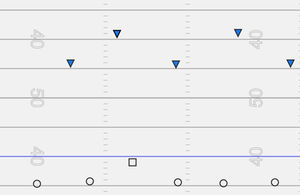It Starts with the Snap - O'Brien Part 1
- Coach G
- May 5, 2019
- 3 min read
Updated: Feb 9, 2020
We have come across several programs who have run some form of the O'Brien and they all become vulnerable to an aggressive defense because they snap the ball in a way that negates their advantage. The biggest key to being successful in the O'Brien is not your blocking, it is not your running back or even your QB. The key to being successful is your center QB exchange.
Many of us older coaches grew up watching the Dallas Cowboys under the direction of Tom Landry and how he revolutionized the sport of football with the "shotgun" snap. Why waste the time of dropping back? Give your thrower more time to make the reads and to see the defense pre-snap. It was so basic and so simple and it made you wonder why it took seventy years to put into place. Through the years, the snap itself has evolved. How deep, what side of the QB, how high, etc. Each of these facets of the snap provide advantage or disadvantage.
In O'Brien, the snap can not be straight back (with the exception of a counter play) and the QB can not be parallel to the line of scrimmage (LOS). The QB must be facing the sideline as though he was sprinting toward it with his hands out so he can catch the ball beings snapped three feet beyond his hands. The key is the QB is effectively in motion at the snap! (See Figure 1)

I once had an opposing coach scream for illegal procedure and get the call because our QB was in motion at the snap. I had to call a timeout and ask the young (11 Man) white hat if I took the QB started him outside as a receiver and then put him in motion and snapped him the ball would it be legal? He thought this through and then proceeded to not throw any more flags. Everyone is familiar with the jet sweep and the ball being directly snapped to the motioning receiver, what they are not familiar with is seeing the QB simulating the same motion at the snap.
To be successful at making this snap you must have the snapper start by looking through his legs with his aim point being the RB. We tell him to snap the ball to the RB. This is very important because it is very difficult to snap a ball to a point in the air and almost impossible for a younger player. The QB is aligned 4 yards behind the Center (Figure 3).

The speed of the snap is also important as we want it to be quick but not fast. The speed and height of the snap will be dependent upon the speed and height of the QB. The QB should catch the snap in front at about his chest (certainly above his waist) so he is in the best position to pitch the ball to the RB.
Coaching Point: It is important to not allow the QB to move toward the LOS at the snap as this is a penalty. Younger QBs will want to shorten the distance to the hole by making their first step toward the LOS.
Why take the snap on the run? It negates the rush from the backside defensive end. We tell our center all he needs to do is get one hand to the chest of the DE to negate penetration down the LOS. You can only pray the opponent puts their fastest player at the backside DE. If so, then check mate! It also allows you to get the QB into a better blocking position and with more momentum as he will be blocking downhill. This leads us to a discussion of the second most important element of the O'Brien.... the QB.
.png)


























Comments